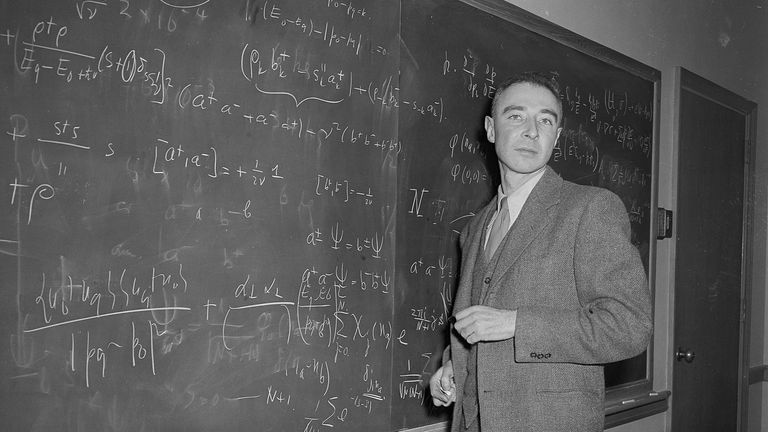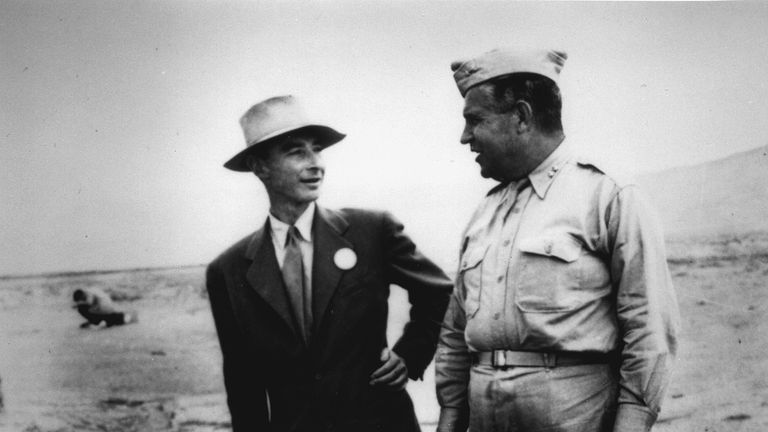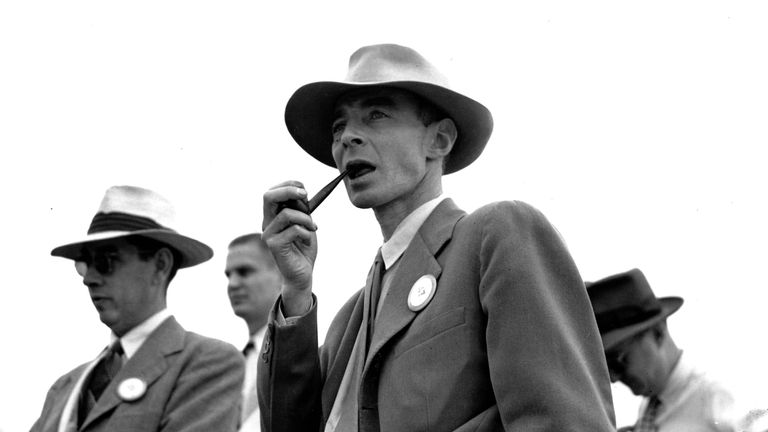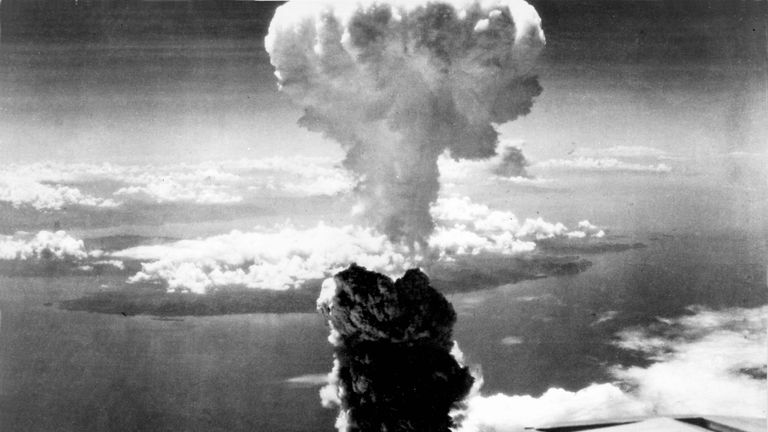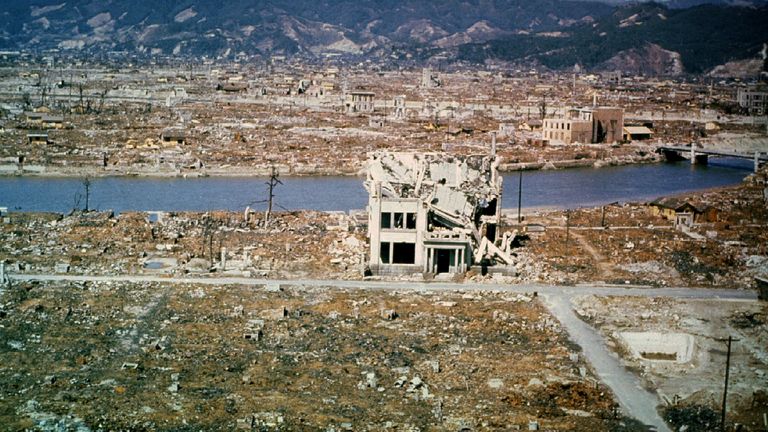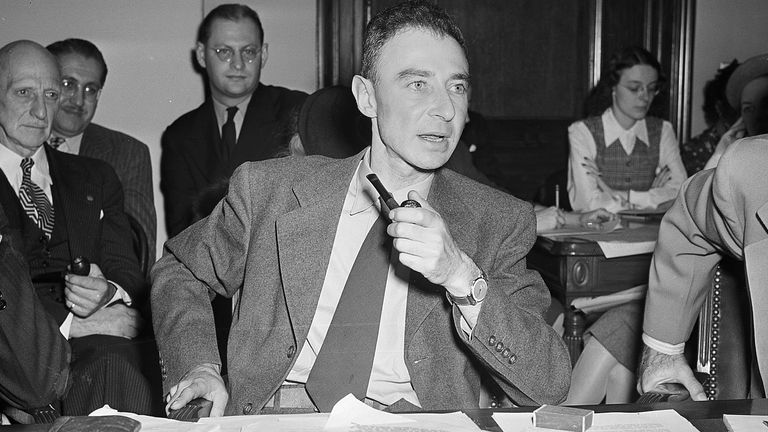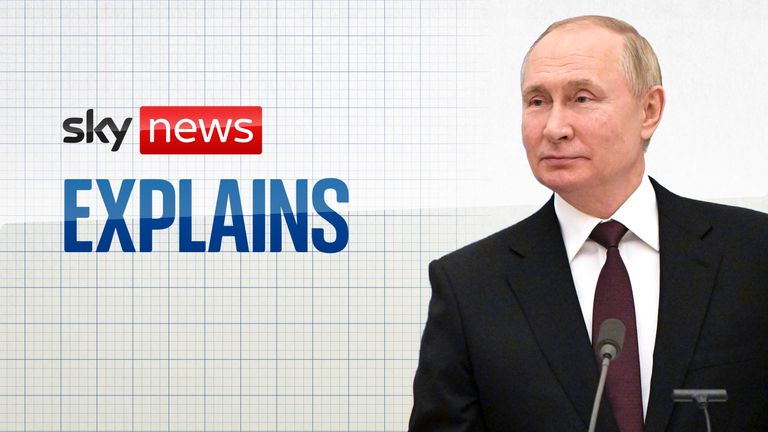Each time Vladimir Putin raises the spectre of nuclear confrontation, the path in the end leads again to 1 man.
Eighty years earlier than the Russian president invaded Ukraine, and brought the potential of such weapons back to mainstream attention, J Robert Oppenheimer was recruited to guide a workforce that might assemble the world’s first atomic bombs.
Ukraine war – follow the latest developments
The Manhattan Project, arrange throughout the Second World War in 1942, was guided by worry that if the US and its allies did not make them first, Hitler’s Nazi scientists would.
A left-wing theoretical physicist not recognized for his management qualities or laboratory acumen, the American was an unconventional choose however proved a devastatingly efficient one.
As blockbuster biopic Oppenheimer hits cinemas, Sky News appears at how the daddy of the atomic bomb nonetheless shapes the world a long time after his creation was deployed.
Read extra:
‘The danger never goes away’
What is the Doomsday Clock and how does it work?
An uncommon recruitment
Oppenheimer was appointed by General Leslie Groves, the mission’s navy chief, to go up Site Y – a secret weapons analysis facility at Los Alamos, New Mexico.
But there have been, as Oppenheimer biographer Professor Ray Monk places it, “all sorts of reasons” to not appoint him, notably perceived affiliation with communist organisations that had made him a suspect of the FBI.
Born to a Jewish household in New York in 1906, his pupil years had seen him drawn to the left as Germany’s fascist regime noticed pals and relations oppressed and compelled to flee.
During research at Harvard, Cambridge, and Germany‘s Gottingen college within the Nineteen Twenties, he was recognized for being a “disaster in the laboratory”. Of his time finding out physics at Harvard, Oppenheimer himself stated: “My feeling about myself was always one of extreme discontent.”
He might have been unconvincing within the lab, however discovered his calling as a college lecturer in California. His capacity to clarify advanced science in a comparatively simple and compelling approach proved key to impressing Groves, who interviewed numerous scientists earlier than an opportunity assembly with Oppenheimer.
Crucially, he additionally recognised the necessity for urgency.
Prof Monk says: “Oppenheimer knew Heisenberg, one of the greatest scientists in the world, who he worked with at Gottingen, was leading the Nazi bomb project and was worried they would get one before the Allies.
“He was in little doubt in any respect – the responsibility of all scientists within the US, and the allied nations, was constructing a bomb first.”
Building the bomb
Los Alamos was certainly one of three websites essential to the event of the atomic bomb.
The others have been a manufacturing facility in Hanford, Washington, the place plutonium was made; and a hidden base in Oak Ridge, Tennessee, for enriching uranium.
The two parts would act as gas for the bombs made at Los Alamos, two of which would be dropped on the Japanese cities of Nagasaki and Hiroshima in August 1945.
Cynthia C Kelly is founder and president of the Atomic Heritage Foundation, devoted to the preservation of the Manhattan Project and essential to having the three websites acquire nationwide park standing within the US.
“It was a first-of-a-kind effort across the board,” she says of the Manhattan Project, named after the New York City district the place it was based.
With the town that by no means sleeps deemed too busy for such a secretive initiative, the three laboratories have been arrange in remoted locations distant from city centres and the coast. They introduced collectively geniuses from throughout America and abroad – together with Britain and a few who fled Nazi Germany – into one single-minded pursuit.
Click to subscribe to Backstage wherever you get your podcasts
“It required creative minds from the machinists to the craftsmen – everything had to be perfect,” Kelly provides, with a “classic absent-minded professor” on the coronary heart of it.
“They had to take this energy, which had been uncontrolled up to now, figure out how to control it, and package it tightly enough to fit in the bomb bay of an aeroplane that could transport it and drop it.
“They had little confidence in harnessing this expertise in time for the tip of the battle.”
Becoming Death
But harness it they did – and the world would change ceaselessly.
The first atomic bomb take a look at in New Mexico occurred on 16 July 1945, after which Oppenheimer uttered a line that, alongside together with his trademark fedora and pipe, has develop into quintessential to his public picture.
“Now I am become Death, the destroyer of worlds,” he noticed after the so-called Trinity Test, quoting a sacred Hindu textual content in a reminder of his acumen as a thinker in addition to a scientist.
A couple of weeks after, dying adopted on an unimaginable scale. On 6 August, a uranium-based bomb named Little Boy was detonated over Hiroshima; and one other, Fat Man, was dropped on Nagasaki three days later.
Both cities have been left unrecognisable, 200,000 individuals died, and Japan surrendered. Oppenheimer was shaken.
“Right up until the dropping of the bomb on Hiroshima, he had no moral qualms whatsoever,” says Prof Monk.
“Even when the Germans surrendered (on 7 May 1945), and it was obvious the Americans were still going to use the bomb against the Japanese, he had no qualms.
“But he thought one demonstration of the superior energy of this weapon was sufficient.”
A brand new world
Despite its undoubted function in ending the Second World War, which price the lives of some 90 million individuals, Oppenheimer was modified by the atomic bomb, believing it made the prospect of future battle “unendurable”.
“It has led us up those last few steps to the mountain pass; and beyond there is a different country,” he stated in 1946, later signalling his opposition to his authorities’s plan to develop even larger nuclear weapons.
Oppenheimer was ignored and held in deep suspicion, and his safety clearance on the Atomic Energy Commission finally rescinded. He died of lung most cancers in 1967 with not one of the energy he as soon as yielded.
Nuclear weapons haven’t been used once more, however the menace lingers. America and Russia’s arsenals are far smaller than their Cold War peak, however they maintain 90% of an estimated international stockpile of 13,000 weapons.
Other nuclear powers embody China, India, Pakistan, and North Korea. Like Putin, Kim Jong Un has on several occasions threatened to use them. The Nuclear Threat Initiative, an organisation centered on lowering nuclear and organic threats, says the world may very well be “sleepwalking into a nuclear disaster”.
Ever since Oppenheimer witnessed the Trinity Test within the New Mexico desert, Cynthia C Kelly says there’s been “no way to put the genie back in the bottle”.
Beyond the mountain
While Oppenheimer failed in his post-war efforts, his work is one of the best instance world leaders have of why they wouldn’t want to risk “mutually-assured destruction” by launching a nuclear weapon.
Two cities devastated past recognition have seemingly served as the last word deterrence.
“Oppenheimer was invited to say he regretted developing the atomic bomb many times, most prominently when he visited Japan, and his answer was always no,” says Prof Monk.
“It can be argued the fact the weapons have never been used again shows deterrence works.”
Read extra:
What nuclear weapons does Russia have?
Beyond deterrence, the Manhattan Project additionally unleashed an period of science and innovation nonetheless being felt right this moment, together with nuclear vitality important to weaning ourselves off greenhouse gases.
Last 12 months, American scientists performed the first-ever nuclear fusion experiment to achieve net energy gain, paving the way in which for a “clean energy source that could revolutionise the world”.
Some consultants have referred to as for a Manhattan Project-style initiative to fight climate change, leveraging the identical urgency and dedication to deal with a disaster that threatens us all. The startling rise of artificial intelligence, already compared to the threat of nuclear weapons by its very creators, might current one other such alternative.
Unfortunately, nothing appears to focus the minds fairly like battle.
“Weapons are one part of the nuclear story, and that will be with us until we blow ourselves up,” says Kelly.
“Hopefully that won’t happen and, as Oppenheimer put it, we can see beyond the mountain.”
Content Source: news.sky.com


